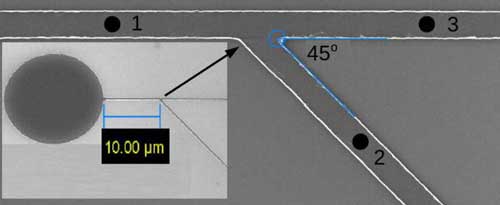| Posted: Mar 07, 2017 |
Magnetic fields at the crossroads
(Nanowerk News) From compasses used in ancient overseas navigation to electrical motors, sensors, and actuators in cars, magnetic materials have been a mainstay throughout human history. In addition, almost all information that exists in contemporary society is recorded in magnetic media, like hard drive disks.
|
|
A team of researchers at the Brazilian Center for Physics Research is studying the motion of vortex domain walls -- local regions of charge that collectively store information via their configuration -- driven by magnetic fields in ferromagnetic nanowires, which are configured in a straight line with an asymmetric Y-like branch. They discuss their work in this week's Journal of Applied Physics ("Trajectory and chirality of vortex domain walls in ferromagnetic nanowires with an asymmetric Y-branch").
|
 |
| Scanning electron microscopy image of the structure including the pad, nanowire, and branch. The zoom shows the branch connected to the bottom nanowire edge by 45° angle. Points 1, 2, and 3 are the positions where the hysteresis cycles with the focused magneto-optical Kerr effect (MOKE) were measured. (© AIP)
|
|
The question posed by the group was: What happens to the vortex wall when it meets the branch? Does it changes it direction or not, or could it be split in two walls?
|
|
"To make a simplistic parallel, if we imagine that the vortex wall is a tornado and the tornado is running on a straight road and encounters a cross-road, what happens next; can it split into two tornados?" said Luiz Sampaio, a researcher at the Brazilian Center for Physics Research in Rio De Janeiro.
|
|
Generally speaking, magnetic fields can be used to change the magnetization of a magnetic material, much like a bar magnet can magnetize an otherwise nonmagnetic sewing needle, and can even reverse its magnetization completely in some cases.
|
|
The process involved in magnetization reversal sometimes exhibits the nucleation and movement of these domain walls, which constitute the transition between two regions of charge magnetized in different directions. Domain wall motion has been widely explored in ferromagnetic nanowires due to their high potential for applications in spintronic devices, those that use the quantum spin properties of electrons.
|
|
The control and manipulation of these domain walls is crucial for successful realizing magnetic memory, logic and sensors devices. By modifying the nanowire geometry, scientists hope to acquire a higher control of the domain wall motion and set a route towards achieving reliability in switching magnetization in ferromagnetic nanowires. The team devised a study using two steps.
|
|
"First, we fabricated samples using electron-beam lithography, magnetron sputtering and lift-off techniques," said Sampaio. After the nanometer-scale fabrication, they then measured the switching magnetization behavior mediated by the domain wall propagation.
|
|
The second step was to carry out micromagnetic simulations to guide and interpret the experimental results. "These two tools allowed us to study in detail the processes of vortex domain walls at the branch entrance," he said.
|
|
Moving forward, the team wants to understand whether the angle between the nanowire and branch can increase the asymmetric behavior at the branch entrance. This would increase the likelihood of observing only one type of vortex domain wall, clockwise or counterclockwise. This will require varying the nanowire angles with the branch to select the vortex chirality.
|
|
Understanding the dynamical aspects of vortex domain walls opens a route to better control of their motion and trajectory. This may be important for producing logic gates, which can be based on the domain wall motion in line with such branches. The magnetization in the branches can be oriented in two different directions along the nanowire axis, where each direction would serve as the "0" and "1" necessary for data storage and processing.
|
|
"To provide the reliability needed for these applications, a higher degree of control in the magnetization switching is required, but to enhance the efficiency of the processes involved in the magnetization switching, the vortex domain wall seems to be a promising candidate," said Sampaio.
|

